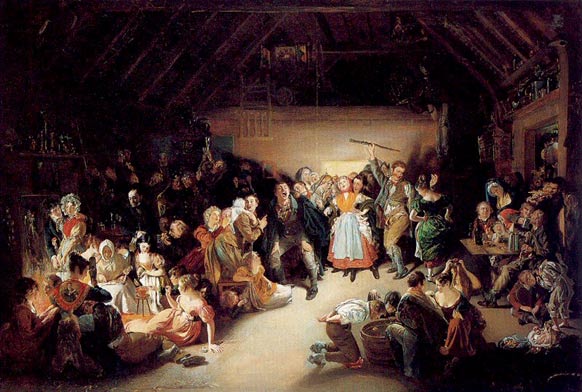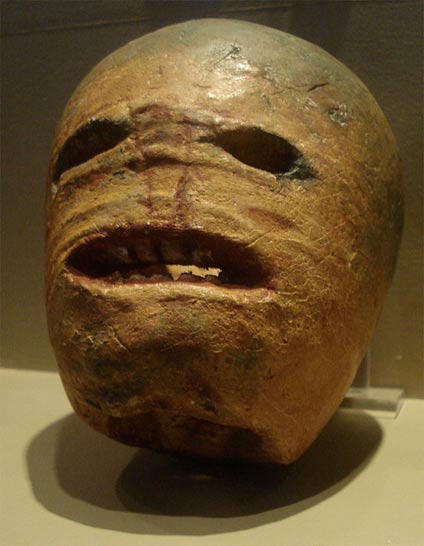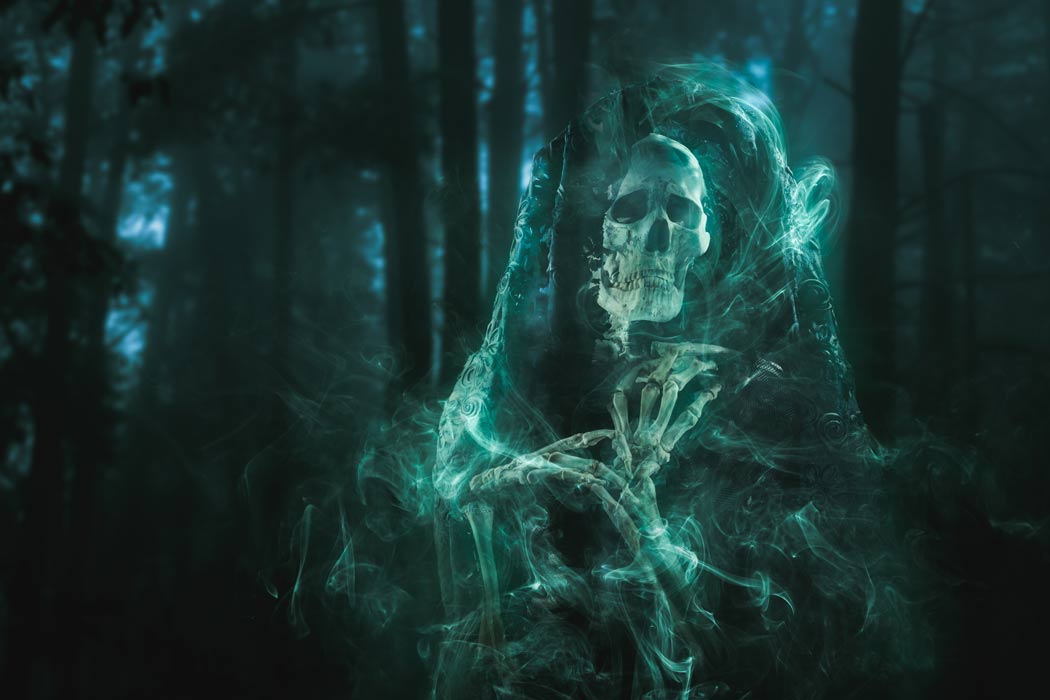Crossing the Veil: The Pre-Christian Origins of Halloween and Samhain
Halloween, or the ancient Samhain, is considered the time of year when the veil between our world and the spirit world is at its thinnest. As darkness falls and families light their pumpkin Jack-o'-lanterns, they are, perhaps unknowingly, repeating the ancient traditions of honoring the dead and marking the beginning of the ‘dark half’ of the year.
Halloween Origins: Celtic Harvest Festivals
Halloween is an annual celebration held largely in the western world on October 31st. Starting in the evening, children, and sometimes adults, dress in masks and costumes, traditionally as ghostly figures, witches, or the undead – vampires, zombies, skeletons. They go knocking door-to-door, requesting treats, or else threatening a mischievous trick upon the household. Typical activities of the modern observance can include costume parties, pumpkin carving, trick-or-treating, lighting bonfires, playing pranks, and more.

Popular Halloween symbols have pre-Christian origins. (bioraven /Adobe Stock)
Hallowe’en, a shortened form of "All Hallows' Evening" is an echo of Celtic harvest festivals of pre-Christian Europe. Observed now in several countries around the world, it is the evening before ‘All Hallows Day’, when saints (hallows) and martyrs are remembered by people of many Christian denominations. This ritual, however, coincides with (and some scholars suggest co-opted) the ancient observance of Samhain.
What were Pagan Rituals on Samhain?
Samhain (pronounced sah-van or sow-in) is the traditional Gaelic festival marking the change of seasons and the approach of winter. There are many important events that begin or happen around the time of Samhain in Irish myth. For example, people would bring their cattle back from the summer pastures and slaughter livestock in preparation for the upcoming winter. They would also light ritual bonfires for protection and cleansing as they wished to mimic the sun and hold back the darkness. It was also a time when people believed that spirits or fairies (the Aos Sí ) were more likely to pass into our world.

A bonfire is an ancient tradition at Samhain. (Cheryl /Adobe Stock)
Dead and departed relatives played a central role in the tradition, as the connection between the living and dead was believed to be stronger at Samhain, and there was a chance to communicate. Souls of the deceased were thought to return to their homes. Feasts were held and places were set at tables as a way to welcome them home. Food and drink was offered to the unpredictable spirits and fairies to ensure continued health and good fortune.
- Halloween CAN Go on With These Fun Ancient Traditions
- Tricking and Treating Has a Long History
- Ex-Devil Worshipper Says: I'm Shocked Christians Celebrate Halloween
Transforming Samhain
The idea that souls return home on a certain day of the year is repeated across many cultures around the world. Día de Muertos, or the Day of the Dead, is a similar holiday held around the same time of year in Mexico celebrating and honoring family members who have died.
Samhain saw a metamorphosis due to the early Church. In The History of Halloween or Samhain, Jack Santino writes:
“As a result of their efforts to wipe out ‘pagan’ holidays, such as Samhain, the Christians succeeded in effecting major transformations in it. In 601 A.D. Pope Gregory the First issued a now famous edict to his missionaries concerning the native beliefs and customs of the peoples he hoped to convert. Rather than try to obliterate native peoples' customs and beliefs, the pope instructed his missionaries to use them: if a group of people worshipped a tree, rather than cut it down, he advised them to consecrate it to Christ and allow its continued worship.”
In the 12th century, obligatory holy days across Europe involved town criers dressed all in black, ringing mournful bells and calling on Christians to remember the poor souls of the dead. Special ‘soul cakes’ would be baked and shared. This custom of “souling” was present in England, Germany, Belgium, Austria, and Italy, and this is thought to be the precursor of trick-or-treating.
Eventually, mumming and guising (going door-to-door in disguise and performing in exchange for food) was taken up as another variation on these ancient customs. Pranks were thought to be a way of confounding evil spirits. Pranks at Samhain date as far back as 1736 in Scotland and Ireland, and this led to Samhain being dubbed “Mischief Night”.

Painting of a Halloween party in Ireland, 1832. By Daniel Maclise. (Public Domain)
Controversy Surrounding Modern Halloween Practices
Many of the modern practices for Halloween date to 19th century England and North America. Fortune telling and divination have traditionally played a part in celebrations. Games were played with the intention to divine one’s future. Nuts and fruit featured in eating and drinking games, and soul cakes were prepared.
Around Halloween, pumpkins are hollowed out, and spooky faces are carved into them, creating Jack-o'-lanterns. Candles are then lit inside the pumpkins, creating eerie lanterns, and serving as signals that a household observes Halloween. Pumpkins are frequently used today as they’re easier to carve and a symbol of harvest, but the original lanterns in Ireland and Scotland were carved from turnips. These turnip lanterns were used to frighten off evil spirits by guisers, and were a motif of the Irish Christian folk tale of Jack, a wandering soul who was denied entry into both heaven and hell.

A traditional Irish turnip Jack-o'-lantern from the early 20th century. (Rannṗáirtí anaiṫni/CC BY SA 3.0)
Observing Halloween is not without controversy. Some religions discourage participation, suggesting that it trivializes Samhain, it has satanic associations, or it is an inappropriate tribute to paganism or the occult. However, the modern practices heavily influenced by commercialization and popular culture differ appreciably from the ancient traditions of Samhain and All Hallows’ Eve.
Still, the connection exists and the history is clear - when you light a Jack-o'-lantern and brighten the darkening season, you’re carrying on an age-old tradition that bridges cultures around the world and reaffirms our connection to our departed loved ones.
Top Image: Halloween has origins in Samhain, a time when the veil between the living and dead is thinnest. Source: fergregory /Adobe Stock
By Liz Leafloor
Updated on October 28, 2020.
References
Halloween Express (2015) ‘The History of Halloween.’ Halloween Express. Available at: https://www.halloweenexpress.com/blog/the-history-of-halloween/
Hansen, R. (2017) ‘Tricking and treating has a history.’ The Conversation. Available at: https://theconversation.com/tricking-and-treating-has-a-history-85720
Newgrange.com (n.d.) ‘Samhain (Samain) - The Celtic roots of Halloween.’ Newgrange.com. Available at: https://www.newgrange.com/samhain.htm
Ramirez, J. (2018) ‘Ex-Devil Worshipper Says: I'm Shocked Christians Celebrate Halloween.’ Ancient Origins. Available at: https://www.ancient-origins.net/history-ancient-traditions/halloween-0010877
Santino, J. (1982) ‘Halloween: The Fantasy and Folklore of All Hallows.’ The American Folklife Center. Available at: https://www.loc.gov/folklife/halloween-santino.html

















Comments
Great article. Of course there’s nothing political about Hallowe’en, any more than there is about New Years Eve of Christmas – that’s ridiculous. Hallowe’en is Ireland’s oldest festival. It predates St. Patrick’s Day by centuries. It’s a public holiday in Ireland and has been celebrated in Ireland with vigour since records began. The Irish word for November is ‘Samhain’ (by the way it is NEVER pronounced Sav-in, it’s ALWAYS pronounced SOW-en. And, please, never ‘Sam Hane’!). It means “the end of the brightness", or perhaps best translated as “the dimming”. It does not mean “Summer’s end” (another misunderstanding) that would be the August festival (and Irish word for August) "Lughnasa”, (made famous by the play and movie, “Dancing at Lughnasa”). The Irish word for Hallowe’en is “Oiche Samhain” (EE-heh SOW-en), or November’s Eve. It's a time when we play party games such as apple dunking (note painting), tell fortunes, dress up and eat barm brac. Irish people really know how to make a party. We’re delighted the rest of the world now joins in with Hallowe’en and St. Patrick’s Day – but the one I wish was celebrated more widely is Nollaig na mBan (look it up!).
Tibs
Some of you folks on here are taking this occult buisness about these holidays way to serious.. Valebtines day an occult holiday? Get real guys. Get your head out of the sand.Didn’t any of you do these things as kids? We celebrated Halloween, Valehtines day and other holidays like that in elementary school. No one ever even heard of this stuff being talked about before. I think it really takes some sick individuals to deprive small kids of fun. Like the article explains Western civilization changed the wat all this stuff was celebrated before.
Anymore you find a lot more super heros and disney princesses than you do Witches, Zombies, Vampires, etc. I was apart of that as a child, I went as Snow White, a Butterfly and a rockstar but I also spent like 4 years in a row going as a witch. I wish there would be a return to more traditional type costumes, but like everything else in America, it's just another commericalize holiday....also, sadly enough about 2 weeks before Halloween even takes place, they have already rolled out the Christmas decorations in the stores...also, no one ever asked me to do a trick. LOL. When I was young it was always a contest to see who could get the most candy. When my little one is old enough I plan on teaching her the real story behind this holiday. I think it's important to know. I hope she'll appreciate it.
love, light and blessings
AB
Is a turnip more of a challenge to carve? Trying to figure out the size of the example turnip picture if anyone would know an estimate.
As was noted in this article, Halloween was incorporated into the Christian faith by Pope Gregory. "In 601 A.D. Pope Gregory the First issued a now famous edict to his missionaries...".
Halloween has no political "slant" Left or Right or anything in between. It stands alone as a worship of the dead. And for Christians who are interested in worshiping the dead, I think they should first read this: Deut. 14: ...1 "Do not cut yourselves or shave the front of your heads for the dead." The instructions laid out in the "Old" Testament were part of everyday life for the newly converted in first-century Judea, except for those who were Hellenistic Jews like Herod. But even if a Hellenistic Jew took on the customs of the heathen he risked being stoned to death.
From the church's humble beginnings (from the 12 Apostles to the present), much has changed, and has been added i.e. Halloween, Christmas, Easter, etc. But all these customs are human constructs devoid of any practicality, except for the "fun factor" that these festivals embrace. So, do what you will, but remember, they all have nothing to do with you and your Creator!
Pages